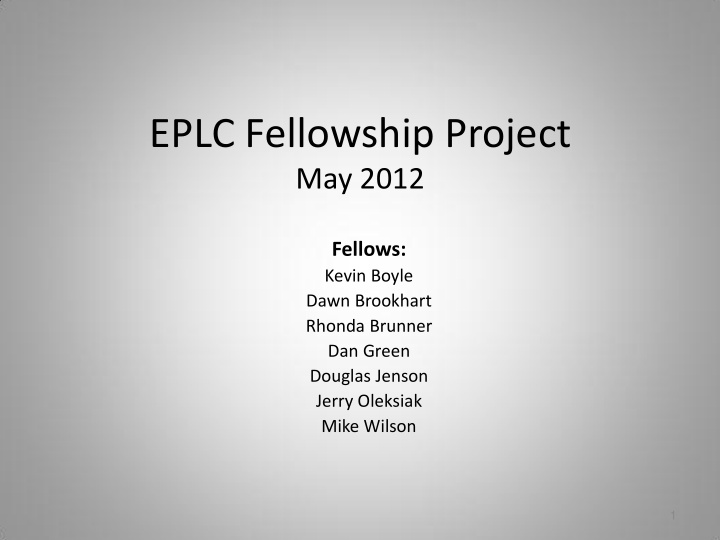



EPLC Fellowship Project May 2012 Fellows: Kevin Boyle Dawn Brookhart Rhonda Brunner Dan Green Douglas Jenson Jerry Oleksiak Mike Wilson 1
Essential Question In this era of accountability, how can educators and policymakers justify and support a broad and rich P-12 curriculum? 2
Accountability • Where we are… • How did we get here… • Where we should be… 3
The Great Misalignment 4
The U.S. The History of Bad Test Takers
http://zhaolearning.com 6
http://zhaolearning.com 7
How has the U.S. performed during the last 40 years in spite of bad test results?
http://zhaolearning.com 9
http://zhaolearning.com 10
http://zhaolearning.com 11
http://zhaolearning.com 12
http://zhaolearning.com 13
http://zhaolearning.com 14
http://zhaolearning.com 15
China Daily, November 27, 2010 The survey covering 21 countries, conducted by International Educational Progress Evaluation Organization, showed Chinese students excelled at math, beating their peers from other countries. But when it came to using their imagination, they were tied for the last place. And in creativity, they were fifth from the bottom. The survey results are not shocking, given the way our children are taught in schools and at home. But they are a stern reminder to our educators and parents to change their ways. The global study should make us swing into action and help our students to throw open their young minds to imagination and creativity. It is time our education officials and educators asked themselves what they should do to let our children's imagination and creativity blossom. http://www.cdeclips.com/en/opinion/fullstory.html?id=55917 16
“No uniform textbooks, no standardized tests, no ranking of students, this is American education in the eyes of a Chinese journalist… American classrooms don’t impart a massive amount of knowledge into their children, but they try every way to draw children’s eyes to the boundless ocean of knowledge outside the school; They do not force their children to memorize all the formulae and theorems, but they work tirelessly to teach children how to think and ways to seek answer to new questions; They never rank students according to test scores, but they try every way to affirm children’s efforts, praise their thoughts, and protect and encourage children’s desire and effort.” Gao Gang, Encountering American Education, #2 most popular item in the category of reportage in China 2003. http://www.360doc.com/content/07/1114/10/50242_820904.shtml 17
http://zhaolearning.com 18
19
20
Why are we placing such emphasis on PSSA testing? Is the floor becoming the ceiling?
What is a Great School? Great Schools … 22
WHAT IS THE CEILING? 23
The Ceiling: 24
Research Study During the spring of 2010, PDE commissioned a research study to analyze and make recommendations regarding the current planning processes and tools used by LEAs and their alignment with the school improvement processes and tools. The study identified the need for a comprehensive process and tool that aligns LEA planning and school-level planning. 25
Comprehensive Planning Project • Under the direction of PDE, Capital Area Intermediate Unit and Delaware County Intermediate Unit are collaborating to design and develop a single, streamlined, yet systemic, comprehensive planning process and plan management system for LEAs and schools within the Commonwealth to ensure that: • LEAs and their schools are using the same proven planning practices. • All planning is collaborative, coordinated and representative of the participation of all stakeholders. • School-level data analysis informs district-level planning; and district resources and activities directly support school improvement. 26
Rationale for Comprehensive Planning Comprehensive Planning is a continuous process used to ensure that all students are achieving at high levels. All districts can create better environments so that more students are successful. Continuous planning of public districts is essential to providing increased student performance and quality results. Innovative, exemplary, and research-based programs, coupled with staff development, focused and aligned resources and public participation in planning, are critical factors in districts that demonstrate continuous growth. 27
Legislative Highlights Submission will consist of a single LEA Comprehensive plan containing up to six goals every three years. Single plan will meet legislative requirements including, but not limited to Chapter 4, 12, 14, 16 and 49. 28
As educational leaders, we have a constitutional obligation to ensure that Pennsylvania meets the constitutional mandate of a “thorough and efficient” system of public education now and into the future. To meet this obligation, we must create learning environments that fit our “great schools” criteria and will support a broad and rich P -12 curriculum that will meet the needs of the whole child. Successful implementation of that curriculum is not measured by a single indicator such as a test score, but a more comprehensive approach to assessment that includes: • This can be achieved through the current system that ensures a comprehensive approach to measuring the alignment of curriculum, instruction, and assessment to the Pennsylvania Common Core Standards 29
Q and A Session
Recommend
More recommend